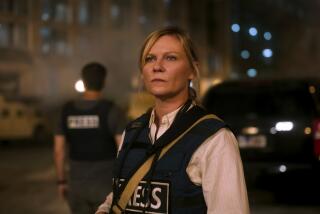Summit pulls the right wire
The 2009 movie season has been relentlessly tough on difficult dramas. There hasn’t been a breakout specialized film release anywhere near last year’s “Slumdog Millionaire.” And ever since Hollywood starting turning out movies about Iraq, audiences (not to mention award voters) have stayed miles away.
“The Hurt Locker,” in other words, had three strikes against it -- before it even stepped up to bat.
But in one of the more noteworthy movie surprises of the year, director Kathryn Bigelow’s look at an American explosive ordnance disposal team in Iraq is making a bang at the art house and seems likely to remain an awards front-runner.
With domestic ticket sales of more than $7 million to date, “The Hurt Locker” is hardly a blockbuster, and isn’t going to help stem the summer’s plummeting sales, in which box-office returns have been down four straight weeks compared with a year ago. Yet Bigelow and screenwriter Mark Boal’s film is on track to gross $15 million or more in its total theatrical run -- an exceptionally strong performance given the film’s subject matter and its absence of recognizable stars.
Just seven weeks into its run, “The Hurt Locker” has performed better than most recent dramas about Middle East conflict. Acquired by Summit Entertainment, the new studio behind the “Twilight” franchise, at last year’s Toronto International Film Festival for $1.5 million, “The Hurt Locker” already has outperformed 2007’s “In the Valley of Elah” ($6.8 million domestic theatrical gross), will soon go by 2008’s “Stop-Loss” ($10.9 million) and even could surpass 2007’s “Lions for Lambs” ($15 million), which starred the A-list triumvirate of Tom Cruise, Meryl Streep and Robert Redford. “The Hurt Locker’s” most crucial role -- the fearless, adrenaline-addicted bomb defuser Staff Sgt. William James -- is played by Jeremy Renner, a veteran character actor perhaps best known for appearing in the horror sequel “28 Weeks Later.”
“The Hurt Locker’s” highly positive critical reception has placed the film in early conversations about a possible best picture Oscar nomination -- a field that is doubling in size from the traditional five movies to 10 nominees in next year’s ceremony. About the only negative notice the movie received from prominent critics came from Daily Variety, which also minimized the film’s box office potential.
From the start, Summit viewed “The Hurt Locker” less as a movie about combat and more as a story of valor. “What we saw was a movie about a hero, not just a movie about the Iraq war,” says Rob Friedman, Summit’s co-chairman and chief executive. “And knowing the previous history of similarly themed movies, we immediately set out to create a different release strategy.”
The first “Hurt Locker” trailers noticeably emphasized the characters’ gallantry (“To do this job,” the trailer’s type said, “you have to be brave.”) and the film’s first round of critical buzz. The sales pitch was directed toward moviegoers older than 25, with coming attractions previews appearing ahead of “State of Play,” “Angels & Demons” and “Public Enemies,” among other adult-oriented dramas.
Instead of opening “The Hurt Locker” soon after the Toronto festival, Summit placed it smack in the middle of the summer, directly opposite “Transformers: Revenge of the Fallen.” The idea was simple: Give critics and cineastes who had been knocked senseless by summer’s mass-appeal onslaught a movie that excited them. As laudatory word-of-mouth built, Summit slowly added the film to a few dozen more theaters each week.
Journalists embraced the movie, so Summit was able to generate reams of free publicity. In the last few days, “Hurt Locker” feature stories have appeared in the Wall Street Journal, the Modesto Bee, the Pittsburgh Post-Gazette and the Santa Fe New Mexican.
For all of the film’s early commercial and critical achievements, Summit now faces a “Hurt Locker” test nearly as tricky as the film’s central theme of disabling Iraqi improvised explosive devices. Younger moviegoers are not flocking to the film, which could limit its ticket sales.
With a per-screen average last weekend of $3,650, “The Hurt Locker” was starting to show signs of cooling off. The far less challenging romance “(500) Days of Summer,” which hasn’t been out as long, had a per-screen average of $10,439 in limited release.
Even as Summit must continue to nurse “The Hurt Locker” through its slowly expanding theatrical release, it needs to make sure the film is not forgotten four months from now, when Academy Award voters are swamped with more heavily promoted holiday-season releases, such as Clint Eastwood’s Nelson Mandela biography “Invictus” and Rob Marshall’s musical “Nine.” At the same time, Summit can’t throw multiple millions of dollars into its Oscar campaign, as that would eliminate “The Hurt Locker’s” profits.
An apt model would be “The Visitor,” another movie that debuted at the Toronto festival. Released by Overture Films last April, the immigration love story did steady art-house business throughout the summer, ultimately topping out at $9.4 million. Overture released the film on DVD in early October, the video release coinciding with Overture’s modestly budgeted (less than $2 million) Oscar push. Though star Richard Jenkins didn’t win an Academy Award (he lost to “Milk’s” Sean Penn), he was at least nominated for the lead actor prize.
“The Hurt Locker” will be playing in 535 theaters this weekend, part of a gradual increase from its premiere in just four locations on June 26. Summit hasn’t announce its DVD date, but is considering a late fall/early winter slot, along with a December theatrical rerelease for Oscar voters in New York and Los Angeles.
Said Friedman: “We will definitely be in everyone’s face when it matters.”
--
More to Read
Only good movies
Get the Indie Focus newsletter, Mark Olsen's weekly guide to the world of cinema.
You may occasionally receive promotional content from the Los Angeles Times.







